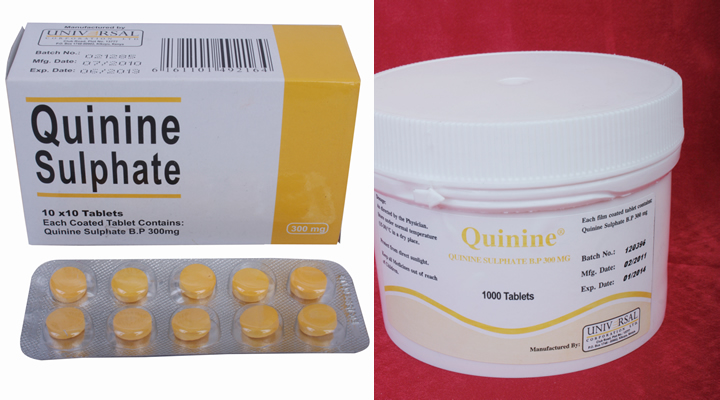
Quinine Tablet
Composition:
Each coated tablet contains: Quinine sulphate B.P. 300mg.
Clinical pharmacology:
- Quinine, a cinchona alkaloid, is a 4-Methanolquinoline antimalarial that is a rapid-acting blood schizontocide with activity against Plasmodium falciparum, P. vivax, P. ovale, and P. malariae. Has activity against gametocytes of P. malariae and P.vivax, but not against mature gametocytes of P.falciparum.
- The precise mechanism of action of quinine is unclear but it may interfere with lysosome function or nucleic acid synthesis in the malaria parasite. It has no activity against exoerythrocytic forms, hence quinine does not produce a radical cure in viva or ovale malarias.
Pharmacokinetics:
- Quinine is rapidly and almost completely absorbed from the gastrointestinal tract and peak concentrations in circulation are attained about 1 to 3 hours after oral administration of the quinine sulphate. It is 70% bound to plasma proteins in healthy subjects and rises to 90% or more in patients with malaria.
- Quinine is widely distributed throughout the body, with concentrations of 2 to 7% of those in plasma being attained in the cerebrospinal fluid (CSF) of patients with cerebral malaria.
- Quinine is extensively metabolized in the liver and rapidly excreted mainly in the urine. Estimates of the proportion of unchanged quinine excreted in the urine vary from less than 5 to 20%. Excretion is increased in acid urine. The elimination half-life is about 11 hours in healthy subjects but may be prolonged in patients with malaria. Small amounts of quinine also appear in the bile and saliva.
- Quinine crosses the placenta and is distributed into breast milk.
Indications and usage:
Despite its potential toxicity, quinine remains the prototype blood schizontocide for the suppressive treatment and cure of chloroquine-resistant and multidrug-resistant falciparum malaria. In the severe illness, prompt use of loading doses of intravenous quinine(or quinidine) is imperative and can be lifesaving for nonimmune patients; oral medication to maintain therapeutic concentrations is then given as soon as it can be tolerated. Especially for treatment of infections with multidrug-resistant strains of P.falciparum, slower acting schizontocides such as sulfonamide or tetracycline are given concurrently to enhance the action of quinine.
Drug interactions:
Absorption of quinine from gastro-intestinal tract can be delayed by antacids containing aluminium. Quinine can delay the absorption and elevate plasma levels of digoxin and related cardiac glycosides, warfarin and related anticoagulants. The action of quinine at neuromuscular junctions will enhance the effect of neuromuscular blocking agents and oppose the action of acetylcholine esterase inhibitors. The renal clearance of quinine can be decreased by cimetidine and increased by acidification of the urine.
Contraindication:
In pregnant women. If the patient becomes pregnant while taking this drug, the patient should be apprised of the potential hazard to the foetus.Quinine is contraindicated in patients with known quinine hypersensitivity and in patients with glucose-6-phosphate dehydrogenase(G-6-PD) deficiency.The drug is contraindicated in patients with tinnitus or optic neuritis or in patients with a history of blackwater fever.
Precautions:
Quinine must be used with considerable caution in patients who manifest hypersensitivity to the drug, especially when this takes the form of cutaneous, angiodematous, visual, or auditory symptoms. Quinine should be discontinued immediately if evidence of hemolysis appears.
Adverse reactions:
When quinine is repeatedly given in full therapeutic doses, a typical dose related cluster of symptoms occurs, termed as cinchonism.Functional impairment of the eighth nerve results in tinnitus, decreased auditory acuity and vertigo. Visual signs consist of blurred vision, disturbed color perception, photophobia, diplopia, night blindness, constricted visual fields, scotomata, mydriasis, and even blindness.Gastro-intestinal symptoms: Nausea, vomiting, abdominal pain and diarrhoea.
Dosage & Admistration:
- Adults: 600mg of quinine sulphate every 8hours for 7days.
- Children: 10mg/kg of quinine sulphate every 8hours for 7days.
Packaging:
Blister pack 10 x 10’s in unit boxes; 100’s, 500’s & 1000’s in securitainer plastic containers.
Storage:
Do not store above 30⁰C . Store in a dry place. Protect from direct sunlight. Keep all medicines out of the reach of children.